Top 5 Vietnam Wholesale Clothing Suppliers: Good Price, High Quality, Reputable
Looking for reliable Vietnam wholesale clothing suppliers to source high-quality apparel at competitive prices? Vietnam has become one of the world’s leading destinations for clothing production — known for its skilled workforce, advanced manufacturing, and ethical production standards. Whether you’re a fashion retailer, boutique owner, or startup brand, partnering with trusted wholesale clothing suppliers in Vietnam ensures access to stylish designs, durable fabrics, and flexible minimum order quantities that perfectly suit your business needs.
1. Where to buy wholesale clothing in vietnam
Finding standard wholesale clothing suppliers from Vietnam can be achieved through various channels. Here are some places that are worth to consider:
1.1. Google
Certainly, when you need to quickly learn about something, you will often think of Google first due to its speed and convenience. The same as when you want to find wholesale clothing suppliers in Vietnam, you will find millions of results within 1 second on Google, including factories, wholesale markets, e-commerce platforms, etc.
Not only that, you will be able to see reviews and feedback from industry insiders or previous customers. And these reviews will be a perfect sign so you can filter out suppliers that suit your needs and choose your partner.
Here are some pros and cons of finding suppliers on Google:
| Pros | Cons |
|
|
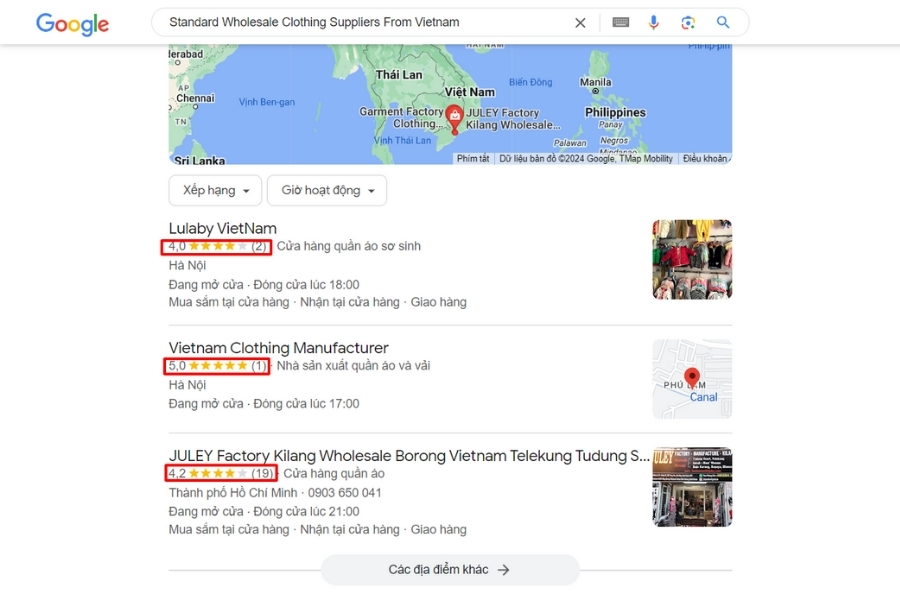
Read More: Top 10 Embroidery Digitizing Companies In United States
1.2. Online B2B Marketplace
Websites like Alibaba, Global Sources, and Made-in-China stand as pillars in the realm of B2B e-commerce, renowned worldwide for their extensive supplier networks and comprehensive offerings. These platforms serve as indispensable tools for wholesale buyers seeking suppliers that align with their specific needs and preferences.
Pros and cons of buying wholesale clothes on online B2B marketplace:
| Pros | Cons |
|
|
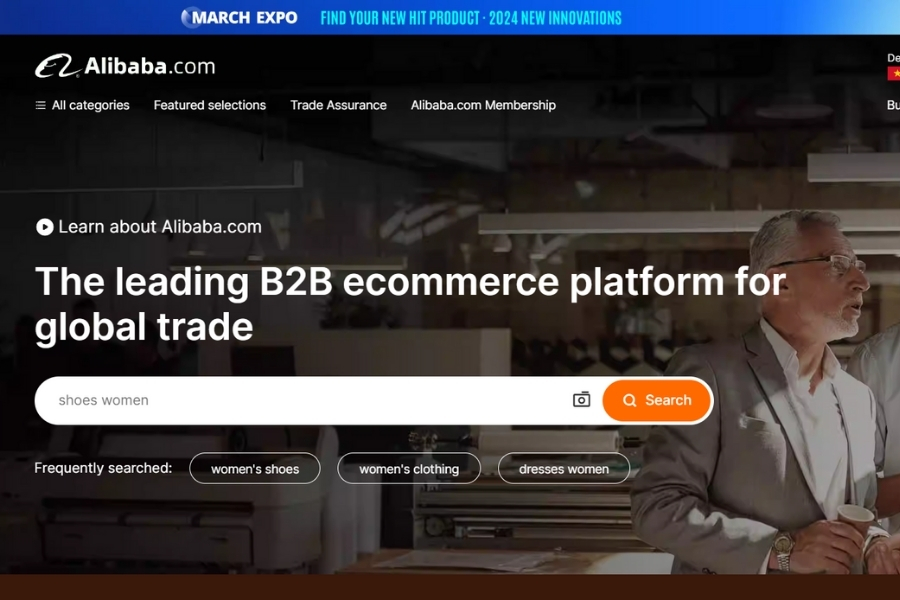
1.3. Vietnam wholesale clothing market
Purchase wholesale clothing at wholesale markets like Ninh Hiep, Dong Xuan, and An Dong markets, which are well-known as the largest wholesale markets in Vietnam. These markets offer a wide variety of clothing styles, designs, and types at varying prices.
The clothing available at these markets is mainly sourced from Guangzhou (China), Thai fashion, or industrial garment factories. One drawback is that some products are of average or low quality, but there are also quality items available, depending on the buyer’s preferences. However, newcomers to these markets may find it challenging to identify quality products.
Additionally, the wholesale prices quoted by suppliers may not always be accurate, as negotiations often depend on personal relationships and demeanor. Experienced traders can discern a buyer’s level of expertise based on their product selection process and communication style.
As a result, inexperienced buyers may end up paying retail prices for wholesale goods, while only those with established relationships or experience can secure the best wholesale deals.
Here are some advantages and disadvantages of buying clothes from wholesale market:
| Pros | Cons |
|
|
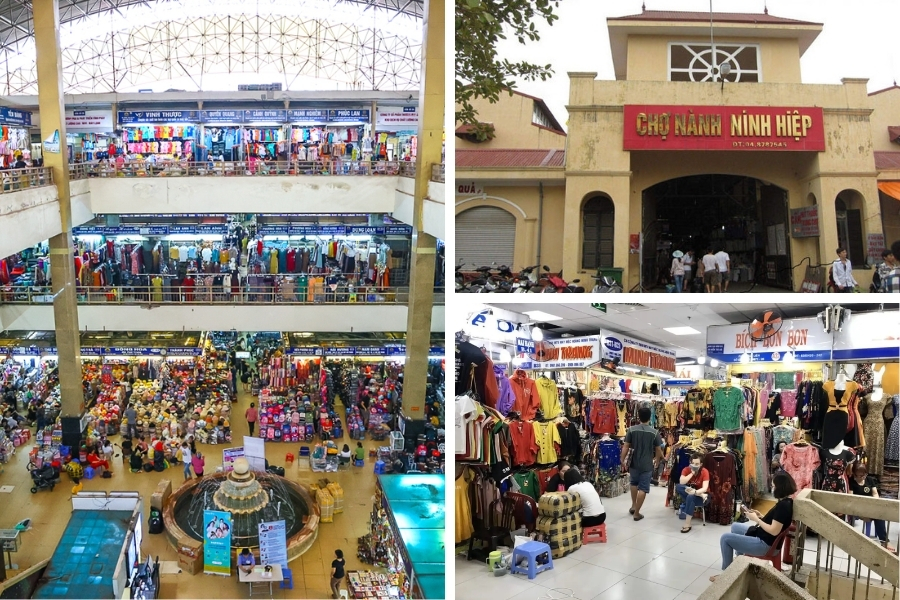
Read More: Top 7 Best Embroidery Factories In Vietnam
1.4. Garment Factories
With concerns about fraud when ordering online or even going to wholesale markets to see products directly, many buyers choose to go to clothing factories to both come into contact with real products and observe their production process. In addition, ordering directly from clothing factories will result in lower wholesale clothing import prices than buying through intermediaries.
When it comes to children’s clothing manufacturing, one name that immediately comes to mind is K-Embroidery. Why? Simply because it is the leading wholesale company in the embroidery industry in Vietnam, always providing opportunities for partners to visit the factory directly to inspect product quality, demonstrating existing prestige.
You are curious? Contact us now for a tour!
Pros and cons of garment factories for buyers wishing to buy wholesale clothing:
| Pros | Cons |
|
|
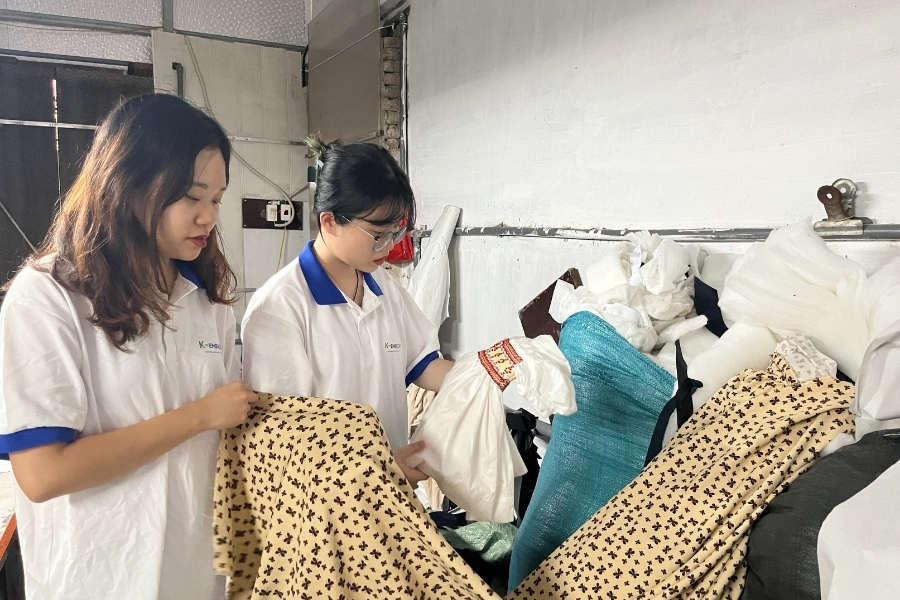
Read More: Top 10 Best Suppliers for Embroidery Fabric Wholesale In the US
1.5. Trade Shows and Exhibitions
Participating in or attending trade shows and exhibitions related to the garment industry is an excellent way to meet suppliers face-to-face, build relationships, and assess the quality of their products. Events like the Vietnam International Fashion Fair (VIFF) or Saigon Fabric & Garment Accessories Expo are worth considering.
In addition, another way for you to find wholesale product suppliers is to contact industry associations such as the Vietnam Textile and Apparel Association (VITAS). They can provide you with valuable insights and connections to reputable suppliers in the country.
Pros and cons of finding wholesale suppliers at trade shows and exhibitions:
| Pros | Cons |
|
|
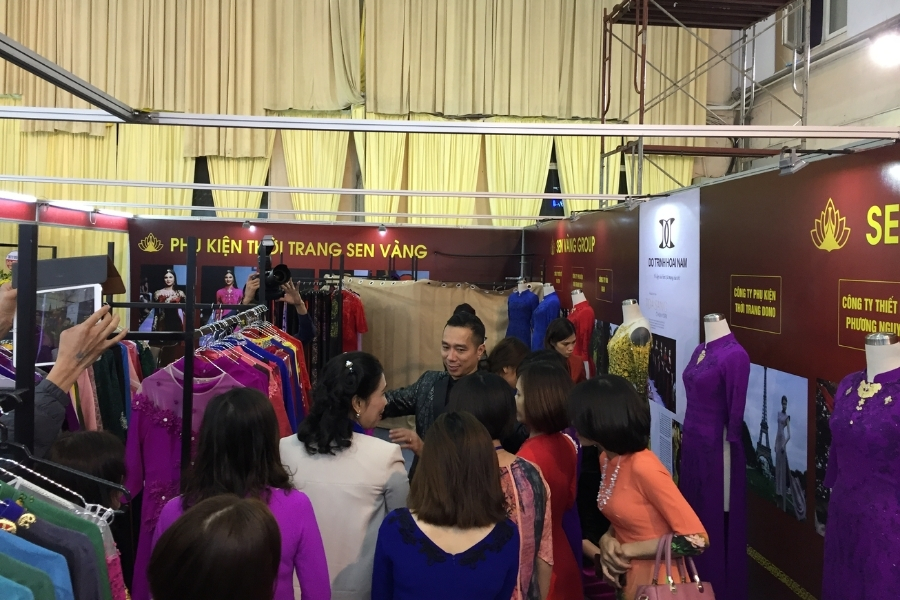
1.6. Social Media and Online Forums
Joining relevant groups or forums on platforms like LinkedIn, Facebook or Reddit can connect you with people knowledgeable about sourcing clothing from Vietnam. These are real buyers and very few people promote their own businesses, so you can rest assured about this.
All you need to do is join wholesale clothes groups and forums, then ask “Can you recommend some reputable wholesale clothes suppliers in Vietnam?”. Many people will help you by answering your questions.
Moreover, you can ask for recommendations or ask about the supplier directly.
And pros and cons of finding suppliers on social media and online forums:
| Pros | Cons |
|
|
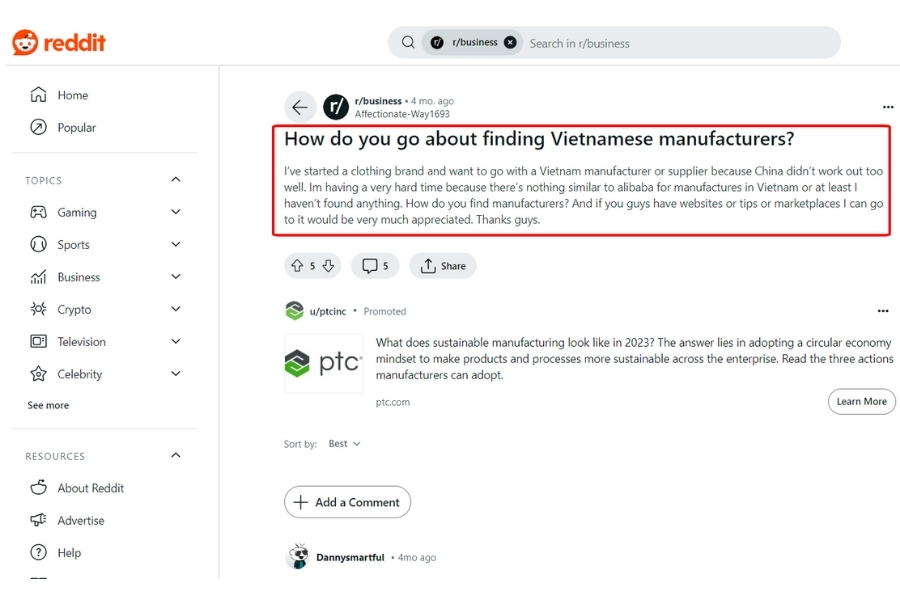
Read More: Top 10+ Best Embroidery Company in UK
2. Top 5 Best Vietnam wholesale clothing suppliers for 2025
2.1. K-Embroidery
K-Embroidery Vietnam stands out as one of the leading Vietnam suppliers of clothes, specializing in high-quality handmade and embroidered garments. With years of expertise in textile production and fashion design, K-Embroidery provides a diverse range of products — from smocked baby outfits and children’s boutique clothing to custom embroidered apparel for global brands. As a reliable Vietnam supplier, the company is committed to ethical production, sustainable materials, and exceptional craftsmanship. Each piece is carefully made with attention to detail, ensuring softness, durability, and beauty. Whether you are a retailer, boutique owner, or clothing brand looking for a trusted partner, K-Embroidery Vietnam suppliers clothes that perfectly blend traditional embroidery artistry with modern fashion trends.
Contact:
- Address: 5th Floor, Building No. 169 Nguyen Ngoc Vu, Cau Giay District, Hanoi
- Hotline: +84855555961
- Website: https://k-embroidery.com/
- WhatsApp: +84855555961
2.2. Sao Mai Trading Company Limited
Sao Mai Trading Company Limited is a wholesale clothing manufacturer in Vietnam specializing in uniform apparel. Sao Mai has won over the trust of innumerable domestic and overseas customers thanks to its longtime production experiences.
They carry a wide range of products, from dresses to blouses, skirts and trousers or t-shirts to well-selected accessories produced by the most high-end fabrics and quality manufacturers.
2.3. TNG Investment & Trading JSC
TNG Investment & Trading JSC is a wholesale supplier of Vietnamese clothing, one of the most dynamic in men’s and women’s wear. Their technical garments for sportswear, workwear, casual wear, shirts, pants (trousers), jackets, and hoodies can be used in any specific field.
TNG — Paving Ways for Sourcing Apparel in Vietnam. The journey of TNG is fueled with innovation & quality to become the trusted partner for businesses sourcing apparel in Vietnam.
2.4. Viet Tien Garment Corporation
Viet Tien Garment Corporation is a large-scale wholesale clothing manufacturer in Vietnam with a global presence. They are known for their commitment to quality, efficiency, and customer satisfaction. Viet Tien produces a diverse range of apparel items, including casual wear, formal wear, and activewear, catering to the needs of international brands and retailers.
Their state-of-the-art facilities and experienced workforce enable them to handle large-scale orders while maintaining high production standards.
2.5. Thanh Hien Cuong Household Business
Thanh Hien Cuong Household Business is a Vietnam clothing production garment specializing in casuallounge, and sleepwear. They offer comfortable and affordable clothing options for everyday use. Their product range includes T-shirts, pajamas, sweatpants, and hoodies made from soft and breathable fabrics. Thanh Hien Cuong is a reliable supplier for businesses looking to source comfortable and stylish casual apparel.
3. Top 5 best vietnam clothes wholesale online in 2025
3.1. K-Embroidery – Vietnam Clothes Wholesale Online for Global Buyers
K-Embroidery is a leading manufacturer offering Vietnam clothes wholesale online, specializing in handcrafted and embroidered garments for babies, children, and families. With a strong focus on quality and design, K-Embroidery combines traditional Vietnamese embroidery techniques with modern fashion trends to create unique, high-end clothing collections. The brand provides a seamless online wholesale experience, allowing international retailers and boutique owners to easily browse, order, and customize products directly from Vietnam. From smocked dresses and baby rompers to seasonal outfits and matching family sets, K-Embroidery Vietnam clothes wholesale online ensures competitive pricing, flexible minimum order quantities, and reliable worldwide shipping — making it the perfect partner for businesses looking to source stylish and ethically made apparel.
3.2. Thitruongsi.com – #1 Vietnam Wholesale Websites
With the scale of a large and reputable online wholesale market, Thitruongsi.com the vietnam wholesale market online has facilitated and connected buyers – wholesalers together in the most convenient and useful way. Up to now, there have been more than 550,000 sellers. The wholesale market has been evaluated and listed in the list of 1 of the websites selling wholesale prices.
There are many factories specializing in wholesale hot girl clothes in Vietnam. The website has provided additional purchases on Google Play and AppStore. Therefore, it has become much easier to view goods and choose from buyers.
3.3. Banbuontonghop.com – Wholesale In Vietnam
Banbuontonghop.com is known as a place to connect and trade for large wholesale needs. On this page, you will find a very large amount of goods to search for the business. If you don’t know how to make money at home and sell products from home on this site, their variety is also appreciated. Currently, Banbuontonghop is a channel for those who are seriously looking for potential business opportunities.
3.4. Thegioisi.vn – Vietnam Wholesale Website
Launched in 2017, Thegioisi has set a record with 70,000 visitors and transactions. However, in the face of serious competitors, Thegioisi has flexibly transformed in the direction of focusing on wholesale distribution of specialized beauty and health care products. Therefore, this website quickly attracts a certain number of customers such as online sellers, pharmacies, spas, salons, nail salons, cosmetic stores, etc.
Currently, Thegioisi is cooperating with leading cosmetic and health care brands such as Dr. Helens, Estee Lauder, M.A.C, L’Oreal, Ohui, Shiseido,… This channel wishes to become an important link for the supply chain of high-quality, wholesale counterfeit products. This website has gradually built its reputation in the online business race.
3.5. Banbuonsieure.com – Vietnam Wholesale Suppliers
If you are a beginner in online business, Banbuonsieure website is the optimal choice for you right now. The website offers a variety of products such as household appliances, accessories – fashion clothes, cosmetics, and children’s toys. At Banbuonsieure, you have the opportunity to own quality products at competitive prices if you buy in bulk.
A plus point for Super Cheap Wholesale is that this website regularly updates hot trending products, suitable for holidays and Tet. However, in order to own products at a reasonable price, you need to enter at least 8 items, each item is at least 5 units (piece/piece).
Read More: Comparison of Woven fabric manufacturing in Vietnam and China, India
4. What Makes A “Standard Wholesale Clothing Factory”?
Suppliers and factories serve as the backbone of the apparel supply chain, demonstrating key attributes that ensure efficiency, quality and reliability in production.
Everyone understands that we need to import goods from reputable, standard clothing suppliers. So have you grasped the standards to create a qualified supplier? Let’s find out with K-Embroidery below.
4.1. Product Quality
Product quality is always the primary criterion for selecting suppliers for retail shops. A good supplier should have commitments to product quality as well as after-sales services such as warranties and product returns for damaged items.
To determine whether a supplier you want to collaborate with provides quality products, you need to gather comprehensive information about the products and the current supplier from various sources, such as from friends, acquaintances, or through your own real-life experiences to make the most accurate assessment.
Furthermore, researching the supplier through online channels such as their own website, information forums, or social media platforms is also a quick way to gather information to help you sort through the suppliers you expect.
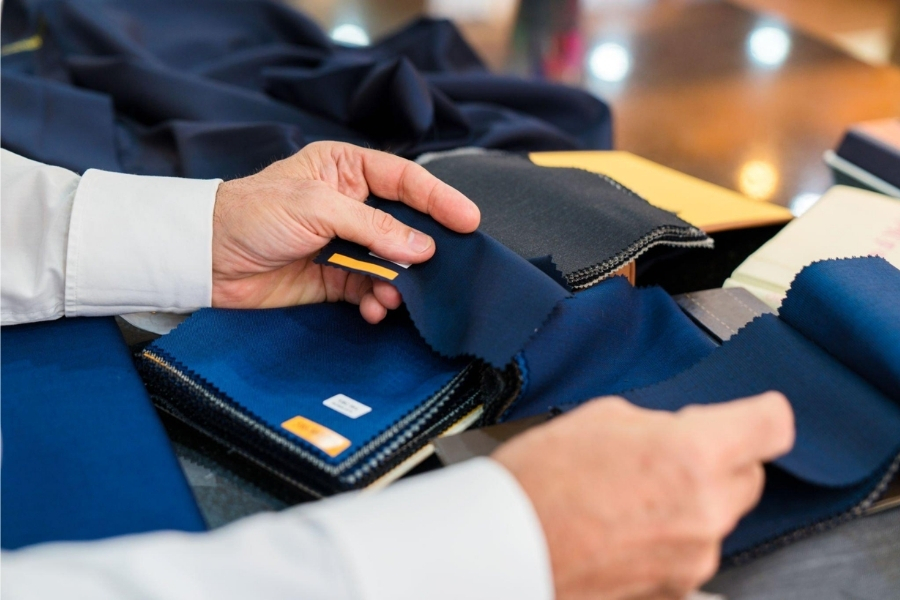
4.2. Rate of Damaged Goods
At any supplier or wholesaler, providing a stable, high-quality, undamaged supply is very difficult and almost inevitable. However, just because of this, we should not always accept damaged shipments, but rather calculate the rate of damaged goods so that you do not incur too much loss.
When choosing a supplier, you must always monitor the quantity/rate of damaged goods upon delivery or damage due to low-quality standards (after quality inspection).
The rate to be determined includes the rate of damaged goods per delivered order, the rate of orders with damaged goods out of the total orders in a statistical period, the value of damaged goods per order, and the total value of damage in a statistical period. From these figures, you will easily compare suppliers within the same product group to make an informed decision on suitable purchases.

4.3. Delivery Time Accuracy
An equally important factor directly affecting the operations of production and business of a business is delivery time. When a supplier delivers on time as agreed upon, it helps you accurately gauge the supplier’s capabilities and their reliability for future orders.
For instance, when you want to place an order for Christmas clothing in Vietnam for retail purposes, but unexpectedly, due to some reasons, the order arrives later than expected, causing you to not have enough clothing on time to meet market demand, and resulting in a significant financial loss. You wouldn’t want that to happen, would you?
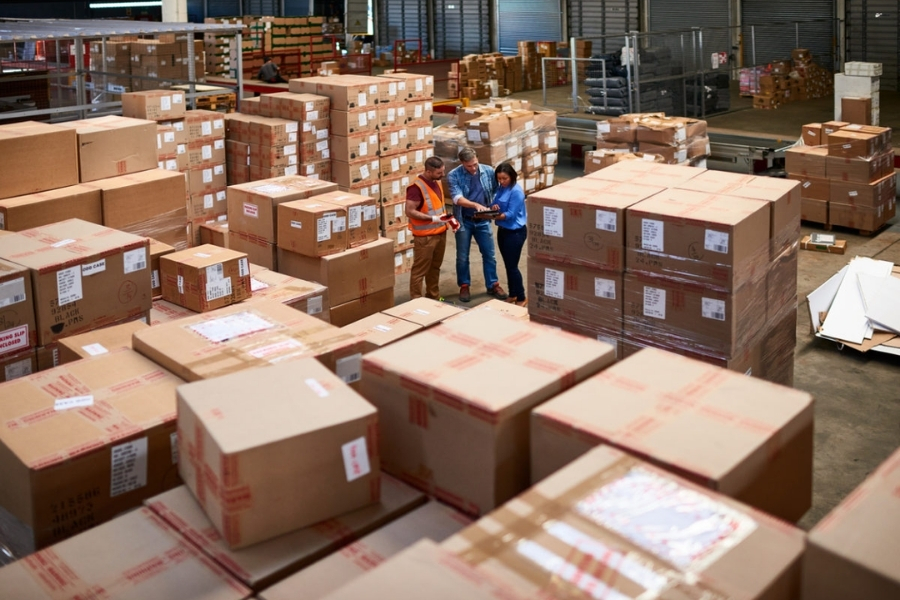
4.4. Product Price
Every entrepreneur knows that the input cost or wholesale price of a product directly affects the revenue of a store. If you bring in products with low cost prices, you can sell them at competitive retail prices and attract customers more easily, right? Simply put, with the same type of goods and quality, any supplier that can offer you a “soft” wholesale price is fully deserving of your collaboration.
Also, you should also pay attention to the delivery costs from the supplier to you because it will always be included in your cost price.
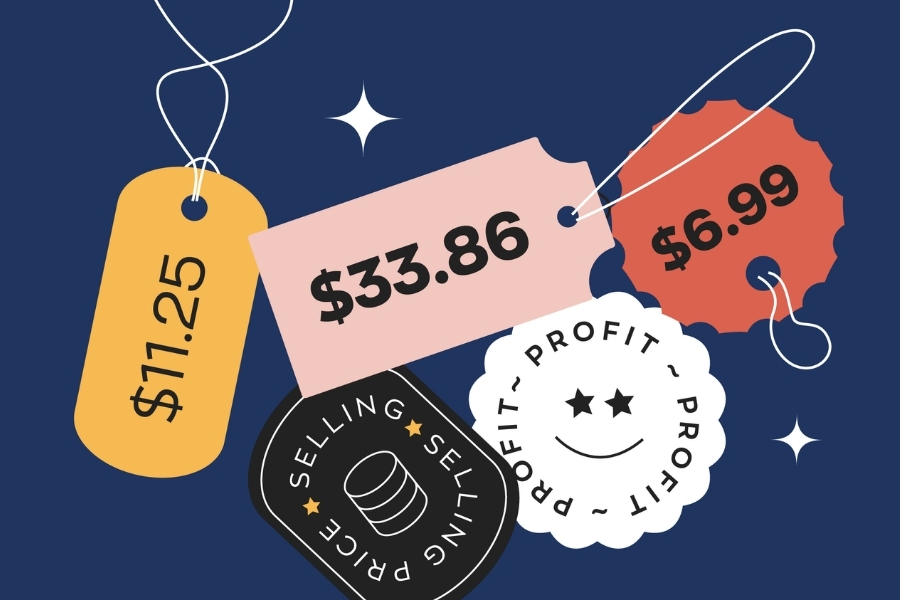
4.5. Warranty or Product Return Policies
Indeed, you will have to carefully consider the product warranty terms, product returns from the supplier. As mentioned in criterion 2, in a large quantity batch, there will be some defective products due to the manufacturing process such as torn seams (for clothing items), adhesive peeling off (for footwear items), etc.
Therefore, before deciding to take the goods, you must ask the supplier clearly about the warranty and whether they allow product returns for defective items or not? This is one of the topmost important rights you need to know when collaborating with a supplier.
And if the supplier has reasonable warranty and product return policies, then that is a very big plus.
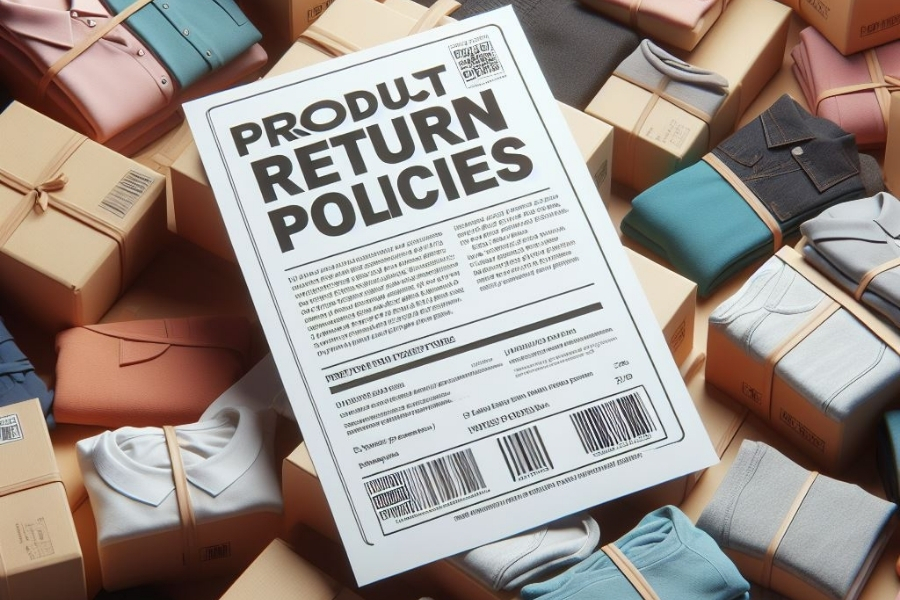
4.6. Compliance and Certifications
Moreover, compliance with international standards and certifications adds credibility to a factory’s operations. Whether it’s ISO certifications or adherence to specific industry regulations, these credentials attest to a factory’s commitment to excellence.
5. 4 Key advantages of partnering with Vietnam clothing manufacturers
- Cost-effective manufacturing with competitive pricing: The combination of labor and streamlined production methods leads to decreased manufacturing costs. This enables large orders to be manufactured at competitive rates, which gives global brands a notable cost edge.
- Skilled labor force and advanced manufacturing technologies: Vietnam’s textile and garment industry has a good workforce—proud workers who have developed informative and deeply researched knowledge through their educational background and hands-on experience. Quality is built into every item they make, from crafting detailed, hand-sewn features to manufacturing in high quantities. Moreover, Vietnam embraced the latest manufacturing technologies and wired them into traditional craftsmanship. Together, this partnership ensures that all clothes meet top-notch standards and come out even if they are small orders. The human touch, care, and precision you can find can only be found in Vietnam’s textile industry.
- High-quality fabrics and materials are available in Vietnam: Vietnam has a mature textile industry, hence access to many quality fabrics and materials. This enables manufacturers to get hold of strong, comfortable, and aesthetically appealing materials, qualities expected from durable woven labels.
- Robust International logistics network: This is due to Vietnam’s location in Southeast Asia, and the country has established a logistics infrastructure over the years. Located close to important shipping routes, the country involves shorter and cheaper transport time for fashion brands that wish to accelerate their overseas supply chain in earlier stages.
6. FAQs
6.1. Why choose Vietnam suppliers for clothes manufacturing?
Vietnam suppliers for clothes are well-known for their high-quality production, competitive pricing, and skilled craftsmanship. The country has a strong textile and garment industry with decades of export experience, making it a trusted hub for global fashion brands. Many Vietnam suppliers also focus on sustainable fabrics and ethical manufacturing practices, ensuring both quality and responsibility in every product.
6.2. What types of clothing can Vietnam suppliers produce?
Vietnam suppliers offer a wide variety of clothing products, including casual wear, children’s clothing, activewear, uniforms, and embroidered garments. Many factories also provide OEM (Original Equipment Manufacturing) and ODM (Original Design Manufacturing) services, allowing buyers to customize styles, fabrics, and branding to match their business needs.
6.3. Are Vietnam clothing suppliers reliable for large orders?
Yes. Most Vietnam suppliers of clothes are equipped with modern machinery, skilled labor, and international-standard quality control systems. Many factories have certifications like ISO, WRAP, or BSCI, ensuring consistency and reliability even for bulk production. Clear communication and sample testing before mass production are key steps that make cooperation smooth and efficient.
6.4. Can I order from Vietnam clothes suppliers online?
Absolutely. Many Vietnam suppliers now offer wholesale and custom clothing services online through professional websites or B2B platforms like Alibaba, Etsy, and their own e-commerce portals. Buyers can browse catalogs, request quotes, place sample orders, and even track shipments — making global sourcing more convenient than ever.
6.5. How can I find trustworthy Vietnam suppliers for clothes?
To find reliable suppliers, start by checking reviews, certifications, production capacity, and communication responsiveness. You can also explore trusted companies like K-Embroidery, which stands out among Vietnam suppliers of clothes for its handcrafted embroidery, premium fabrics, and international shipping services. Partnering with verified suppliers helps ensure product quality, timely delivery, and long-term cooperation.
7. Conclusion
In conclusion, finding reliable Vietnam Wholesale Clothing Suppliers can be achieved through several effective methods. Visiting garment factories directly is a great way to evaluate product quality and production capacity firsthand. You can also search online through major platforms like Alibaba or Made-in-China, or attend trade shows where many trusted suppliers gather in one place. Additionally, social media groups and online forums offer valuable insights and connections from experienced buyers who source clothing from Vietnam.
Each approach has its own benefits and challenges, so it’s essential to research carefully and stay alert to potential scams. By using these strategies wisely, you can connect with reputable Vietnam Wholesale Clothing Suppliers and secure high-quality products for your business — whether through online channels, trade fairs, or direct factory visits.
Contact K-Embroidery manager to buy high quality, cute and safe hand-sewn products for children via WhatsApp: +84855555961 to get the best price and order now!
Contact:
- Address: 5th Floor, Building No. 169 Nguyen Ngoc Vu, Cau Giay District, Hanoi
- Hotline: +84855555961
- Website: https://k-embroidery.com/
- WhatsApp: +84855555961


